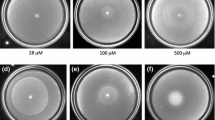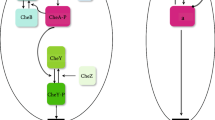Abstract
In E. coli, chemotactic behavior exhibits perfect adaptation that is robust to changes in the intracellular concentration of the chemotactic proteins, such as CheR and CheB. However, the robustness of the perfect adaptation does not explicitly imply a robust chemotactic response. Previous studies on the robustness of the chemotactic response relied on swarming assays, which can be confounded by processes besides chemotaxis, such as cellular growth and depletion of nutrients. Here, using a high-throughput capillary assay that eliminates the effects of growth, we experimentally studied how the chemotactic response depends on the relative concentration of the chemotactic proteins. We simultaneously measured both the chemotactic response of E. coli cells to l-aspartate and the concentrations of YFP-CheR and CheB-CFP fusion proteins. We found that the chemotactic response is fine-tuned to a specific ratio of [CheR]/[CheB] with a maximum response comparable to the chemotactic response of wild-type behavior. In contrast to adaptation in chemotaxis, that is robust and exact, capillary assays revealed that the chemotactic response in swimming bacteria is fined-tuned to wild-type level of the [CheR]/[CheB] ratio.



Similar content being viewed by others
References
Adler J (1966) Chemotaxis in bacteria. Science 153:708–716
Adler J (1973) A method for measuring chemotaxis and use of the method to determine optimum conditions for chemotaxis by Escherichia coli. J Gen Microbiol 74:77–91
Adler J, Dahl MM (1967) A method for measuring motility of bacteria and for comparing random and non-random motility. J Gen Microbiol 46:161
Alon U, Camarena L, Surette MG et al (1998) Response regulator output in bacterial chemotaxis. EMBO J 17:4238–4248
Alon U, Surette MG, Barkai N et al (1999) Robustness in bacterial chemotaxis. Nature 397:168–171
Amann E, Ochs B, Abel KJ (1988) Tightly regulated tac promoter vectors useful for the expression of unfused and fused proteins in Escherichia coli. Gene 69:301–315
Bainer R, Park H, Cluzel P (2003) A high-throughput capillary assay for bacterial chemotaxis. J Microbiol Methods 55:315–319
Barkai N, Leibler S (1997) Robustness in simple biochemical networks. Nature 387:913–917
Belas R, Erskine D, Flaherty D (1991) Proteus mirabilis mutants defective in swarmer cell differentiation and multicellular behavior. J Bacteriol 173:6279–6288
Bilwes AM, Alex LA, Crane BR et al (1999) Structure of CheA, a signal-transducing histidine kinase. Cell 96:131–141
Cluzel P, Surette M, Leibler S (2000) An ultrasensitive bacterial motor revealed by monitoring signaling proteins in single cells. Science 287:1652–1655
Emonet T, Cluzel P (2008) Relationship between cellular response and behavioral variability in bacterial chemotaxis. Proc Natl Acad Sci USA 105:3304–3309
Guzman LM, Belin D, Carson MJ et al (1995) Tight regulation, modulation, and high-level expression by vectors containing the arabinose PBAD promoter. J Bacteriol 177:4121–4130
Kollmann M, Lovdok L, Bartholome K et al (2005) Design principles of a bacterial signalling network. Nature 438:504–507
Li M, Hazelbauer GL (2004) Cellular stoichiometry of the components of the chemotaxis signaling complex. J Bacteriol 186:3687–3694
Lovdok L, Kollmann M, Sourjik V (2007) Co-expression of signaling proteins improves robustness of the bacterial chemotaxis pathway. J Biotechnol 129:173–180
Lutz R (1996) Untersuchungen zur Aktivierung und Repression von Sigma70 Promotoren in Escherichia coli. PhD Thesis, Heidelberg
Lutz R, Bujard H (1997) Independent and tight regulation of transcriptional units in Escherichia coli via the LacR/O, the TetR/O and AraC/I1-I2 regulatory elements. Nucl Acids Res 25:1203–1210
Mesibov R, Adler J (1972) Chemotaxis toward amino-acids in Escherichia coli. J Bacteriol 112:315
Parkinson JS, Houts SE (1982) Isolation and behavior of Escherichia coli deletion mutants lacking chemotaxis functions. J Bacteriol 151:106–113
Paulsson J (2004) Summing up the noise in gene networks. Nature 427:415–418
Sherris D, Parkinson JS (1981) Posttranslational processing of methyl-accepting chemotaxis proteins in Escherichia coli. Proc Natl Acad Sci USA 78:6051–6055
Spiro PA, Parkinson JS, Othmer HG (1997) A model of excitation and adaptation in bacterial chemotaxis. Proc Natl Acad Sci USA 94:7263–7268
Stock JB, Lukat GS, Stock AM (1991) Bacterial chemotaxis and the molecular logic of intracellular signal transduction networks. Annu Rev Biophys Biophys Chem 20:109–136
Stock AM, Robinson VL, Goudreau PN (2000) Two-component signal transduction. Annu Rev Biochem 69:183–215
Toker AS, Macnab RM (1997) Distinct regions of bacterial flagellar switch protein FliM interact with FliG, FliN and CheY. J Mol Biol 273:623–634
Tso WW, Adler J (1974) Negative chemotaxis in Escherichia coli. J Bacteriol 118:560–576
Welch M, Oosawa K, Aizawa S et al (1993) Phosphorylation-dependent binding of a signal molecule to the flagellar switch of bacteria. Proc Natl Acad Sci USA 90:8787–8791
Welch M, Oosawa K, Aizawa SI et al (1994) Effects of phosphorylation, Mg2+, and conformation of the chemotaxis protein CheY on its binding to the flagellar switch protein FliM. Biochemistry 33:10470–10476
Acknowledgments
We thank V. Sourjik (Heidelberg) for plasmids pVS103 and pVS127 and J.S. Parkinson (University of Utah) for the RP4992 strain. Wendy Grus provided editorial assistance. This research was funded by NSF DMR award 0213745 to MRSEC at the University of Chicago and NIH award R01AI059195-03 to PC.
Author information
Authors and Affiliations
Corresponding author
Electronic Supplementary Material
Below is the link to the electronic supplementary material.
Rights and permissions
About this article
Cite this article
Park, H., Guet, C.C., Emonet, T. et al. Fine-Tuning of Chemotactic Response in E. coli Determined by High-Throughput Capillary Assay. Curr Microbiol 62, 764–769 (2011). https://doi.org/10.1007/s00284-010-9778-z
Received:
Accepted:
Published:
Issue Date:
DOI: https://doi.org/10.1007/s00284-010-9778-z




